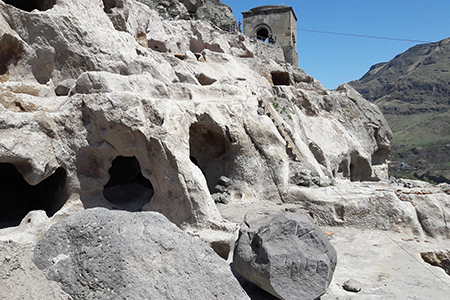Experts restoring fire-damaged paintings at Vardzia monument

Restoration professionals are involved in works to clean unique wall paintings at Georgia’s Vardzia cave complex that were damaged in a fire at the 12th century monument last year.
The National Agency for Cultural Heritage Preservation of Georgia said on Thursday experts were working to remove layers of soot from the paintings at at one of the most iconic historical sites of the country.
The work is proceeding at the Temple of Assumption of Virgin Mary, part of the complex of caves cut into the rock that served as place of residence and religious service since since the second half of the 12th century.

The restoration work is proceeding at the monument located in Georgia's south. Photo: Georgia's Culture Ministry press office.
The restoration work is done by a team from Tbilisi State Academy of Arts, following their earlier joint work at the site with representatives of the Courtauld Institute of Art in London, the United Kingdom.
As part of the international cooperation, the Georgian and British professionals assessed the damage and carried out tests to determine methods for restoring the paintings damaged in the fire at the complex.
Their work will also include issuing recommendations for authorities for setting up a fire extinguishing system at the site in addition to equipment for cleaning air within the enclosed areas.
The monument will also be equipped with technology to ensure maintenance of humidity and temperature at the monument as well as set up lighting.
The temple was closed down following the fire that broke out at the site on October 31, 2016.
The incident was reportedly caused by a candle lit and left near icons and church literature in the temple space.

Vardzia is one of Georgia's most important cultural heritage sites and a popular tourist destination. Photo: Georgia's Culture Ministry press office.
The restoration of the wall paintings at the monument is proceeding along with works launched earlier at the site for strengthening "critical segments” of its facade, said the heritage preservation agency.
These involve installing safety nets to catch falling stones and reinforcing large cliffs with selective drilling done by expert mountaineers. The project was launched by the agency and the Ministry of Culture and Monument Protection of Georgia in 2014.
The 12th-13th century cave complex of Vardzia in Georgia’s south is one of the primary tourist destinations in the country and is visited by thousands of travellers every year.
The site features hundreds of rooms and passageways connecting the caves carved into rock formations, with areas for religious service, residential and storage designation found throughout the complex.
The area of the Vardzia monument also includes remains of the ancient village of Tchatchkari, located on the north-eastern slope of the rock formation that houses the Vardzia caves on its southern side.
The settlement served as the supplier of wine for storage facilities in Vardzia throughout the Middle Ages.
Georgian authorities recently announced plans to restore the village to reflect its historic role and connect it with the general tourist route in Georgia’s historic Javakheti region.
 Tweet
Tweet  Share
Share